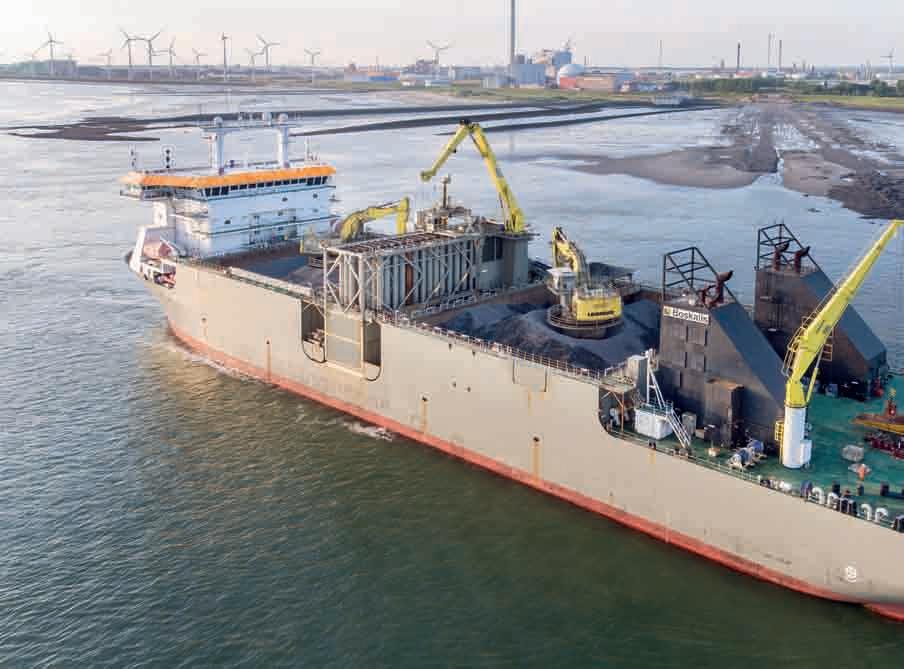
3 minute read
Seventy-one gravity-based foundations for Fécamp offshore windfarm
THE 497MW FÉCAMP OFFSHORE WINDFARM IN FRANCE HAS COMMENCED CONSTRUCTION. THE WIND POWER PROJECT IS THE THIRD French offshore windfarm to achieve financing. Éolien Maritime France (EMF), a consortium of EDF Renewables, Enbridge, and wpd, are the owners of the windfarm.
The project is located in the eastern part of La Manche (the English Channel), off the coast of Haute-Normandie, at approximately 13km northwest of the town of Fécamp. It will consist of 71 Siemens Gamesa 154-7.0MW direct drive wind turbines that will be installed on gravitybased foundations. The total project capital cost is estimated at EUR 2 billion, of which the majority will be financed through nonrecourse project level debt. Fécamp offshore wind project is under-pinned by a 20-year power purchase agreement (PPA), granted by the state in June 2018.
Gravity-based foundations Royal Boskalis Westminster (Boskalis) in consortium with Bouygues Travaux Publics (Bouygues) and Saipem have been awarded the design work, construction, and installation scope for the 71 concrete Gravity Based Structures (GBS) as foundation for the windfarm. The contract carries a total value of EUR 552 million, with a contract value split of 40.5% (Bouygues Travaux Publics), 40.5% (Saipem), and 19% (Boskalis). The 71 wind turbines will be connected to the gravity-based foundations installed on the seabed at depths between 25m and 30m. Within the consortium, consortium leader Bouygues and Saipem are tasked with the design, construction, and installation on the seabed of the gravitybased foundations with an individual weight of up to 5,000t required to provide the stability of the 7MW wind turbines. Boskalis is assigned with the design and preparation of the seabed rock foundation prior to GBS
Assembling of turbines at the Port of Cherbourg.

Fécamp offshore windfarm
Marshalling yard
Construction of GBFs and turbines at Le Havre

The Fécamp offshore windfarm will be located 13km northeast of the town of Fécamp.
Boskalis will be responsible for the design and preparation of the seabed rock foundation prior to GBS installation and the scour protection and ballasting of the GBSs after installation on the seabed.
installation and the scour protection and ballasting of the GBSs after installation on the seabed. Geotechnical studies carried out by the project owner in September 2011 have enabled the refining of knowledge of the chalk’s characteristics, representing the site’s geology. These studies made it possible to specify the dimensioning of foundations and redirect the project towards gravity foundations. The construction of the gravity foundations in the Bougainville maritime works yard in Le Havre will mobilise several hundreds of people for nearly three years.
Unique expertise To carry out the windfarm project, EOHF has selected internationally recognised companies in the fields of civil engineering
Construction of a gravity-based foundation of a metmast in the Bougainville maritime works yard at the port of Le Havre. Constructing GBFs for the Fécamp offshore windfarm will create several hundreds of jobs for a period of three years.

and construction, dredging, offshore installation, and maritime works. With this unique combination of expertise, the consortium partners are confident to successfully deliver and contribute to the French government’s energy mix diversification programme. Apart from the aforementioned consortium for the GBSs, Siemens Gamesa Renewable Energy (SGRE) will produce the 71 wind turbines at its new turbine plant in Le Havre, creating approximately 750 jobs. According to Siemens Gamesa, this new factory will be the first in the world to manufacture complete blades and nacelles under one roof. Chantiers de l’Atlantique, GE Grid Solutions, and SDI are responsible for the offshore substation. RTE is taking care of connecting the windfarm from the substation to the coast and to Normandy’s electricity grid. The wind turbines will be assembled at the Port of Cherbourg. Works should be completed by the end of 2022. The commissioning and operational start-up of the windfarm is planned for 2023. With a total power output of some 500MW, the Fécamp offshore windfarm should produce the equivalent of the domestic electricity consumption of approximately 770,000 people, representing more than 60% of the inhabitants of the Seine-Maritime department.










